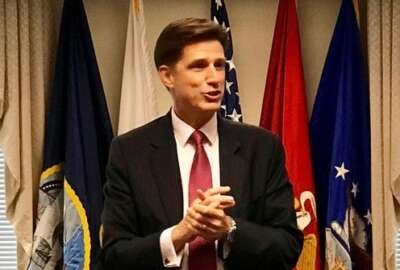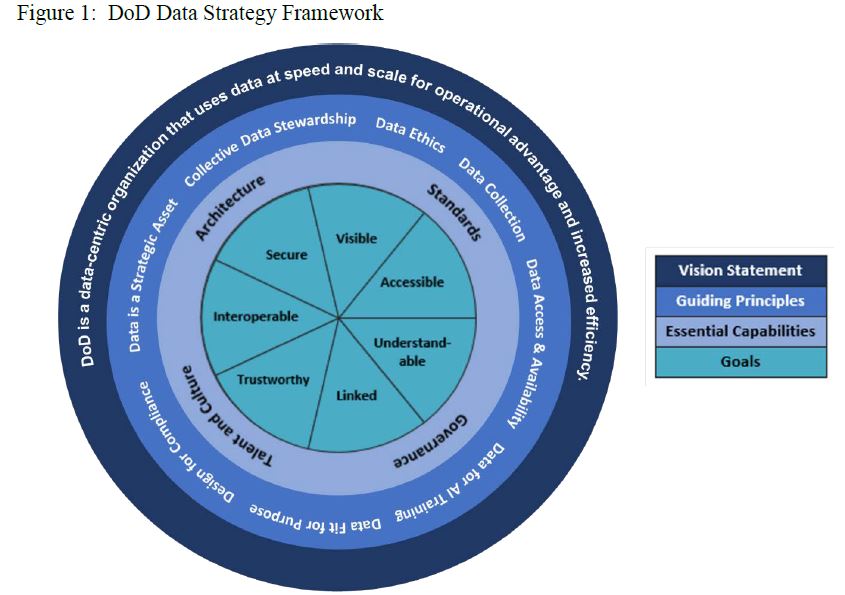
DoD to establish data commandments based on new strategy
The Defense Department finalized its first-ever data strategy focused on eight guiding principles and seven goals to bring some standardization and governance to...
The Defense Department’s new data strategy is less about reeling in what the services and defense agencies have been doing over the last five years.
Rather, DoD is trying to bring some coordination, some semblance of governance to what some may call the wild west of data.
The Pentagon will use the eight guiding principles of the plan to ride herd over the ever growing mound of data it collects.
“DoD leadership has demanded that we address the need to manage and share our data. We must prioritize these efforts by focusing on the needs of the warfighter,” said a DoD official, who spoke to reporters on the condition of anonymity. “The strategy provides the overarching vision, focus areas, guiding principles, essential capabilities and goals necessary to transform the department into a data-centric enterprise.”
Each of the seven goals, which range from making data visible to making data understandable to making data secure, will include objectives and eventually key performance indicators to provide evidence of the change the strategy hopes to drive in the coming years.

In the strategy, DoD recognized that each service and agency already is knee deep in using, governing and collecting data. The official said by creating a path or roadmap, operationalizing and increasing efficiency of decision making will happen more quickly.
“Data is the ammunition in the Digital Modernization Strategy and is increasingly central to warfighter advantage on and off the battlefield,” said Dana Deasy, the DoD chief information officer, in a statement. “The National Defense Strategy directed us to be more lethal, efficient and interoperable with partners. This strategy is our first step to making that ammo persistently available to the men and women of the DoD regardless of echelon or geographic location.”
The DoD official added it must treat data systems with the same priority as weapons systems and equip the warfighter today and in the future.
CDO Council to lead effort
This is why the implementation of the strategy is more important than the document itself.
The official said the DoD chief data officers council and data stewards and teams at the combatant command and field agencies will help promote the standards and, maybe more importantly, bring the warfighter’s perspective to the effort.
“One of things we are going to do is establish almost what you would call a list of data commandments that we hope to publish as complimentary decision type of memo, and a series of other documents and activities that will require certain things and reward good behaviors with the proficiency and efficiency improvements,” said the official. “Finding those authoritative documents that we can say you must use open data standards architecture, you must implement standard application programming interfaces (APIs) protocols and formats and you have to catalog important data. We need to identify what even is important data in the department. We have so much data that if we tried to save and curate it all, it would be a fool’s errand. We need to understand which parts are most important for our business units. The military departments are doing a good job of that now. What we hope to do from the center is to be able to codify how all of this integrates properly and ensure that if we see something moving off track that we have those KPIs to recognize early and steer it back in.”
The official pointed to work the DoD CIO’s office is doing with the Office of Acquisition and Sustainment to refresh a 1993 policy on how to acquire and handle contractor data associated with hardware and software purchases as one example of how the data strategy already is having an impact.
“It’s a pretty powerful statement that across the department we are working together at this point. It’s not just the CDO. It’s everybody using good data behaviors and modern thought processes that will carry us into the future where implementation becomes a lot easier,” he said. “Inside the CDO Council, we actually have specific working groups that are very active in this space drawing the department together. One is workforce, talent and culture. One is decision rights, which is a governance type body. The next is minimum guidelines, which is really policy. Then we have data services, which is about data architecture.”
The official said another way to ensure implementation of the strategy is through the data stewards program. While it’s still early, the official said DoD surveyed soldiers and civilians to better understand where the data experts are across department.
“Where are the data professionals in the department? Who do they report to? Where do we have concentrations? Where do we have gaps?” the official said. “[The CDO] wants to personally have a conversation with every data leader across the department and understand if they consider themselves a CDO, what their organization looks like and if they had one wish from the DoD CDO, what would that be? It’s a mapping opportunity for us.”
The official said the goal is to understand how those organizations that are ahead of others set up their chief data officer’s office, what worked, what hasn’t and how have they codified the CDO structure, and then share what they have learned with others in DoD, who can then use that as a model to create their own data-driven organizations.
Culture and workforce
Another key aspect of implementation is training, which is why talent and culture is an essential capability and a working group topic.
“A modern, agile, information-advantaged DoD workforce (leaders, service members, civilians, and contractors) will be increasingly empowered to work with data, make data-informed decisions, create evidence-based policies, and implement effectual processes,” the strategy states. “We must carefully cultivate our data talent to create and sustain these capabilities. We must provide data skill training, establish centers for data engineering excellence, and foster a supportive ecosystem for collaboration among data experts.”
The official said DoD will take some of the best practices and courses from the services and agencies like the Air Force with its Digital University or Joint Special Operations University’s recent three-day event on artificial intelligence and data management and share them more broadly across the department.
“There are a variety of opportunities both formal and informal that what we should be doing and thinking about as a department is almost recognizing this is almost a language program where we need some people who sure can speak five-plus languages, but at the same time, there are some commanders who just need to know why they need to speak that language. There is a 101 level, there is a power user and there’s a how do I get to the power user track? We are developing a lot of those concepts and plans now.”
The CDO recently brought on a new person to lead that culture and workforce line of effort. The official said they will have more to talk about in the next six months.
Copyright © 2025 Federal News Network. All rights reserved. This website is not intended for users located within the European Economic Area.
Jason Miller is executive editor of Federal News Network and directs news coverage on the people, policy and programs of the federal government.
Follow @jmillerWFED
Related Stories






